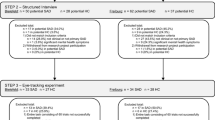Abstract
Background
Avoidance of the eye region, especially of faces showing anger, may maintain social anxiety symptoms by negatively reinforcing expectations and fears associated with social situations. Eye-tracking research, however, has yet to explicitly examine differences in attention allocation to the eye region of emotional faces among adolescents with social anxiety disorder (SAD).
Methods
Gaze patterns were explored in a sample of youth with and without SAD matched on age and sex.
Results
Adolescents with SAD were quicker to fixate, and maintained their initial gaze longer, to the eye region, regardless of emotion, relative to teens without SAD. Group-level differences also emerged for initial fixation duration directed to the eye region of angry faces (when compared with happy faces).
Conclusions
These findings suggest that vigilance to the eye region of faces, especially angry faces, (when compared with happy faces) is characteristic of adolescents with SAD. Adolescents with SAD seem drawn to the eye region, more so than teens without SAD.


Similar content being viewed by others
Notes
The other metrics (latency and first fixation duration) were not examined given limited power to run analyses since repeated measures ANOVA will exclude data from subjects who only allocated attention to the eyes; specifically, latency and first fixation duration have missing data because if attention was not first allocated to the eye region, it is coded as a missing value (e.g., “999” or “NaN”) not a “0” value. A “0” value would skew latency and first fixation duration averages since those metrics rely on time, not number of trials.
References
Allen, K. B., Woody, M. L., Rosen, D., Price, R. B., Amole, M. C., & Silk, J. S. (2019). Validating a mobile eye tracking measure of integrated attention bias and interpretation bias in youth. Cognitive Therapy and Research, 44, 668–677.
Armstrong, T., & Olatunji, B. O. (2012). Eye tracking of attention in the affective disorders: A meta-analytic review and synthesis. Clinical Psychology Review, 32, 704–723.
Beesdo-Baum, K., & Knappe, S. (2012). Developmental epidemiology of anxiety disorders. Child and Adolescent Psychiatric Clinics, 21(3), 457–478.
Birmaher, B., Khetarpal, S., Brent, D., Cully, M., Balach, L., Kaufman, J., & McKenzie Neer, S. (1997). The screen for child anxiety related emotional disorders (SCARED): Scale construction and psychometric characteristics. Journal of the American Academy of Child and Adolescent Psychiatry, 36, 545–553.
Bögels, S. M., & Mansell, W. (2004). Attention processes in the maintenance and treatment of social phobia: Hypervigilance, avoidance and self-focused attention. Clinical Psychology Review, 24, 827–856.
Buckner, J. D., Maner, J. K., & Schmidt, N. B. (2010). Difficulty disengaging attention from social threat in social anxiety. Cognitive Therapy and Research, 34, 99–105.
Capriola, N., Maddox, B. B., & White, S. W. (2016). No offense intended: Fear of negative evaluation in adolescents and adults with autism spectrum disorder. Journal of Autism and Developmental Disorders (Special Issue on ASD and Anxiety). Advance online publication.
Capriola-Hall, N. N., Ollendick, T. H., & White, S. W. (2019). Gaze as an indicator of selective attention in adolescents with Social Anxiety Disorder. Cognitive Therapy and Research, 44, 145.
Carleton, R. N., Collimore, K. C., McCabe, R. E., & Antony, M. M. (2011). Addressing revisions to the brief fear of negative evaluation scale: Measuring fear of negative evaluation across anxiety and mood disorders. Journal of Anxiety Disorders, 25, 822–828.
Coffman, M. C., Trubanova, A., Richey, J. A., White, S. W., Kim-Spoon, J., Ollendick, T. H., & Pine, D. S. (2015). Validation of the NIMH-ChEFS adolescent face stimulus set in an adolescent, parent, and health professional sample. International Journal of Methods in Psychiatric Research, 24, 275–286.
Cooney, R. E., Atlas, L. Y., Joormann, J., Eugène, F., & Gotlib, I. H. (2006). Amygdala activation in the processing of neutral faces in social anxiety disorder: Is neutral really neutral? Psychiatry Research: Neuroimaging, 148(1), 55–59.
de Hullu, E., de Jong, P. J., Sportel, B. E., & Nauta, M. H. (2011). Threat-related automatic associations in socially anxious adolescents. Behaviour Research and Therapy, 49, 518–522.
Dodd, H. F., Hudson, J. L., Williams, T., Morris, T., Lazarus, R. S., & Byrow, Y. (2015). Anxiety and attentional bias in preschool-aged children: An eyetracking study. Journal of Abnormal Child Psychology, 43, 1055–1065.
Dudeney, J., Sharpe, L., & Hunt, C. (2015). Attentional bias towards threatening stimuli in children with anxiety: A meta-analysis. Clinical Psychology Review, 40, 66–75.
Egger, H. L., Pine, D. S., Nelson, E., Leibenluft, E., Ernst, M., Towbin, K. E., & Angold, A. (2011). The NIMH child emotional faces picture set (NIMH-ChEFS): A new set of children’s facial emotion stimuli. International Journal of Methods in Psychiatric Research, 20, 145–156.
Eisenbarth, H., & Alpers, G. W. (2011). Happy mouth and sad eyes: Scanning emotional facial expressions. Emotion, 11, 860–865.
Erceg-Hurn, D. M., & Mirosevich, V. M. (2008). Modern robust statistical methods: An easy way to maximize the accuracy and power of your research. American Psychologist, 63, 591–601.
Frischen, A., Bayliss, A. P., & Tipper, S. P. (2007). Gaze cueing of attention: Visual attention, social cognition, and individual differences. Psychological Bulletin, 133, 694–724.
Gamble, A. L., & Rapee, R. M. (2010). The time-course of attention to emotional faces in social phobia. Journal of Behavior Therapy and Experimental Psychiatry, 41, 39–44.
Gotlib, I. H. (1982). Self-reinforcement and depression in interpersonal interaction: The role of performance level. Journal of Abnormal Psychology, 91, 3–13.
Green, M. J., Williams, L. M., & Davidson, D. (2003). Visual scanpaths to threat-related faces in deluded schizophrenia. Psychiatry Research, 119, 271–285.
Grossmann, T. (2017). The eyes as windows into other minds: An integrative perspective. Perspectives on Psychological Science, 12, 107–121.
Haxby, J. V., Hoffman, E. A., & Gobbini, M. I. (2002). Human neural systems for face recognition and social communication. Biological Psychiatry, 51, 59–67.
Keil, V., Hepach, R., Vierrath, S., Caffier, D., Tuschen-Caffier, B., Klein, C., & Schmitz, J. (2018). Children with social anxiety disorder show blunted pupillary reactivity and altered eye contact processing in response to emotional faces: Insights from pupillometry and eye movements. Journal of Anxiety Disorders, 58, 61–69.
In-Albon, T., Kossowsky, J., & Schneider, S. (2010). Vigilance and avoidance of threat in the eye movements of children with separation anxiety disorder. Journal of Abnormal Child Psychology, 38, 225–235.
Leary, M. R. (1983). A brief version of the fear of negative evaluation scale. Personality and Social Psychology Bulletin, 9, 371–375.
Michalska, K. J., Machlin, L., Moroney, E., Lowet, D. S., Hettema, J. M., Roberson-Nay, R., et al. (2017). Anxiety symptoms and children’s eye gaze during fear learning. Journal of Child Psychology and Psychiatry, 58, 1276–1286.
Moukheiber, A., Rautureau, G., Perez-Diaz, F., Soussignan, R., Dubal, S., Jouvent, R., & Pelissolo, A. (2010). Gaze avoidance in social phobia: Objective measure and correlates. Behaviour Research and Therapy, 48, 147–151.
Öhman, A. (1986). Face the beast and fear the face: Animal and social fears as prototypes for evolutionary analyses of emotion. Psychophysiology, 23, 123–145.
Öhman, A., Flykt, A., & Esteves, F. (2001). Emotion drives attention: Detecting the snake in the grass. Journal of Experimental Psychology: General, 130, 466–478.
Ollendick, T. H., White, S. W., Richey, J., Kim-Spoon, J., Ryan, S. M., Wieckowski, A. T., et al. (2019). Attention bias modification treatment for adolescents with social anxiety disorder. Behavior Therapy, 50, 126–139.
Pitskel, N. B., Bolling, D. Z., Hudac, C. M., Lantz, S. D., Minshew, N. J., Vander Wyk, B. C., & Pelphrey, K. A. (2011). Brain mechanisms for processing direct and averted gaze in individuals with autism. Journal of Autism and Developmental Disorders, 41, 1686–1693.
Price, R. B., Kuckertz, J. M., Siegle, G. J., Ladouceur, C. D., Silk, J. S., Ryan, N. D., et al. (2015). Empirical recommendations for improving the stability of the dot-probe task in clinical research. Psychological Assessment, 27, 365–376.
Rappaport, B. I., Pagliaccio, D., Pine, D. S., Klein, D. N., & Jarcho, J. M. (2017). Discriminant validity, diagnostic utility, and parent-child agreement on the Screen for Child Anxiety Related Emotional Disorders (SCARED) in treatment-and non-treatment-seeking youth. Journal of Anxiety Disorders, 51, 22–31.
Rapee, R. M., & Heimberg, R. G. (1997). A cognitive-behavioral model of anxiety in social phobia. Behaviour Research and Therapy, 35, 741–756.
Rapee, R. M., Oar, E. L., Johnco, C. J., Forbes, M. K., Fardouly, J., Magson, N. R., & Richardson, C. E. (2019). Adolescent development and risk for the onset of social-emotional disorders: A review and conceptual model. Behaviour Research and Therapy, 123, 103501.
Ristic, J., Mottron, L., Friesen, C. K., Iarocci, G., Burack, J. A., & Kingstone, A. (2005). Eyes are special but not for everyone: The case of autism. Cognitive Brain Research, 24, 715–718.
Schmidtendorf, S., Wiedau, S., Asbrand, J., Tuschen-Caffier, B., & Heinrichs, N. (2018). Attentional bias in children with social anxiety disorder. Cognitive Therapy and Research, 42, 273–288.
Schneier, F. R., Rodebaugh, T. L., Blanco, C., Lewin, H., & Liebowitz, M. R. (2011). Fear and avoidance of eye contact in social anxiety disorder. Comprehensive Psychiatry, 52, 81–87.
Schulze, L., Renneberg, B., & Lobmaier, J. S. (2013). Gaze perception in social anxiety and social anxiety disorder. Frontiers in Human Neuroscience, 7, 872.
Seefeldt, W. L., Krämer, M., Tuschen-Caffier, B., & Heinrichs, N. (2014). Hypervigilance and avoidance in visual attention in children with social phobia. Journal of Behavior Therapy and Experimental Psychiatry, 45, 105–112.
Shechner, T., Jarcho, J. M., Britton, J. C., Leibenluft, E., Pine, D. S., & Nelson, E. E. (2013). Attention bias of anxious youth during extended exposure of emotional face pairs: An eye-tracking study. Depression and Anxiety, 30, 14–21.
Silverman, W. K., & Albano, A. M. (1996). Anxiety disorders interview schedule for DSM-IV (child and parent versions). San Antonio, TX: Psychological Corporation.
Staugaard, S. R. (2010). Threatening faces and social anxiety: A literature review. Clinical Psychology Review, 30, 669–690. https://doi.org/10.1016/j.cpr.2010.05.001.
Tipples, J. (2006). Fear and fearfulness potentiate automatic orienting to eye gaze. Cognition & Emotion, 20, 309–320.
Watson, D., & Friend, R. (1969). Measurement of social-evaluative anxiety. Journal of Consulting and Clinical Psychology, 33, 448–457.
Wechsler, D. (2011). Wechsler abbreviated scale of intelligence (2nd ed.). San Antonio: Psychological Corporation.
White, S. W., Maddox, B. B., & Panneton, R. K. (2015). Fear of negative evaluation influences eye gaze in adolescents with autism spectrum disorder: A pilot study. Journal of Autism and Developmental Disorders, 45, 3446–3457.
Wieckowski, A. T., & White, S. W. (2017). Eye-gaze analysis of facial emotion recognition and expression in adolescents with ASD. Journal of Clinical Child & Adolescent Psychology, 46, 110–124.
Wieser, M. J., Pauli, P., Weyers, P., Alpers, G. W., & Mühlberger, A. (2009). Fear of negative evaluation and the hypervigilance-avoidance hypothesis: An eye-tracking study. Journal of Neural Transmission, 116, 717–723.
Funding
This work was partially supported by the National Institute of Mental Health, Grant 5R34MH096915 [PI: Ollendick] and the Virginia Tech Graduate Research Development Program.
Author information
Authors and Affiliations
Corresponding author
Ethics declarations
Conflict of Interest
The authors have no conflicts of interest.
Research Involving Human and Animal Rights
All study procedures were approved by the institutional review board for human subject research.
Informed Consent
All participants provided informed consent.
Additional information
Publisher's Note
Springer Nature remains neutral with regard to jurisdictional claims in published maps and institutional affiliations.
Rights and permissions
About this article
Cite this article
Capriola-Hall, N.N., Ollendick, T.H. & White, S.W. Attention Deployment to the Eye Region of Emotional Faces among Adolescents with and without Social Anxiety Disorder. Cogn Ther Res 45, 456–467 (2021). https://doi.org/10.1007/s10608-020-10169-2
Accepted:
Published:
Issue Date:
DOI: https://doi.org/10.1007/s10608-020-10169-2




